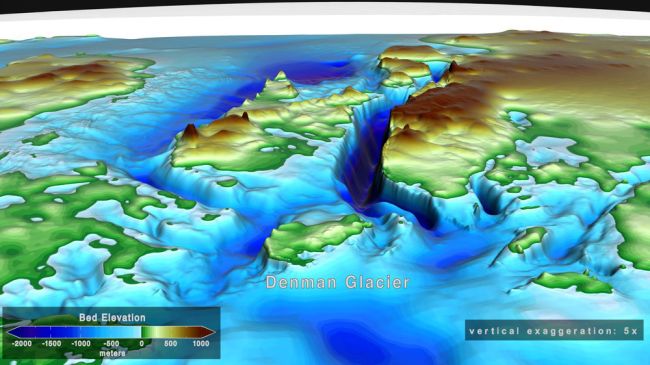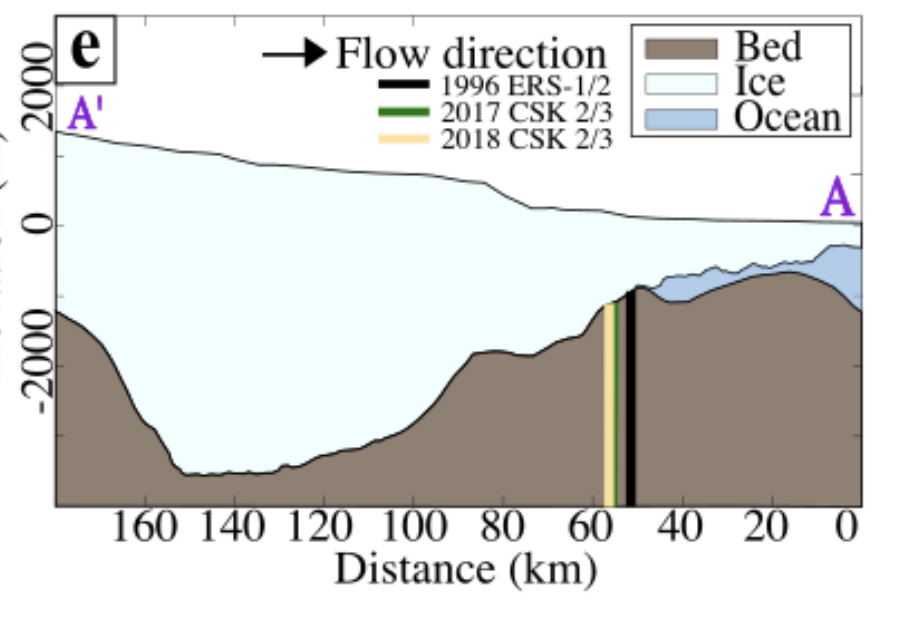Antarctica's Denman Glacier is sinking into the world's deepest canyon
The melting glacier could raise sea level by almost 5 feet (1.5 meters).

The glaciers of Antarctica are melting at unprecedented rates, and a giant canyon in the continent's rocky underbelly could make matters much worse.
In a study published March 23 in the journal Geophysical Research Letters, researchers used more than 20 years of satellite data to monitor the ice in Denman Glacier — a 12-mile wide (20 kilometers) stream of ice in East Antarctica — along with the bedrock beneath it. The researchers found that, not only did Denman's western flank retreat nearly 3 miles (5 km) between 1996 and 2018, but that a deep canyon below the glacier may be causing the glacier to melt faster than it can possibly recover.
Denman Glacier's western flank flows over the deepest known land canyon on Earth, plunging at least 11,000 feet (3,500 meters) below sea level. Right now, that canyon (known as the Denman trough) is mostly cut off from the sea thanks to all the glacial ice piled inside and atop the ravine. However, as the glacier's edge continues to retreat farther and farther down the slope, warm ocean water will pour into the canyon, battering bigger and bigger sections of the glacier and gradually turning the Denman trough into a giant bowl of meltwater with nowhere else to go.
This scenario, the researchers wrote, could kick off a runaway feedback loop of melt that ultimately returns all of Denman Glacier's ice to the sea — risking nearly 5 feet (1.5 m) of global sea level rise.
"Because of the shape of the ground beneath Denman's western side, there is potential for rapid and irreversible retreat, and that means substantial increases in global sea levels in the future," lead study author Virginia Brancato, a postdoctoral fellow with NASA's Jet Propulsion Laboratory, said in a statement.
Losing frozen ground

Glaciers are giant slabs of ice sitting atop continental bedrock. Most glaciers in Antarctica, including Denman, end in large ice shelves or "tongues" that jut away from the land and into the open ocean, where their edges slowly snap into pieces and form new icebergs. The point where a glacier first leaves the bedrock and begins to float in the water is called the grounding line. The location of this line is key to a glacier's stability; when warm ocean water melts away exposed glacial ice, the grounding line retreats farther and farther back, making nearby ice sheets less stable and more prone to melting and cracking.
In the new study, researchers used satellite data from the German Aerospace Center and the Italian Space Agency to measure how far Denman Glacier's grounding line retreated in the 22 years between 1996 and 2018, and how much mass the glacier lost in melted ice. They saw extensive melting — Denman lost more than 268 billion tons (2.43 metric tons) of ice in those two decades — and an alarming rate of retreat on one side of the glacier only.
Get the Space.com Newsletter
Breaking space news, the latest updates on rocket launches, skywatching events and more!
While there was little retreat on Denman's eastern flank (where a rocky ridge stabilizes the grounding line), the glacier's western flank shot back by nearly 3 miles (5 km), plunging partway down the slope of the massive Denman trough.
If current global warming trends continue, that trough could spell doom for Denman glacier, the researchers wrote. As the glacier's grounding line continues to sink farther down the canyon (which already sits below sea level), warm ocean water will batter larger and larger chunks of the glacier's edge, causing it to melt even faster and make the precarious ice shelf above even more vulnerable to collapse.
If that happens, it's likely that Denman Glacier will undergo a "rapid and irreversible retreat" with "major consequences" for sea level rise, the researchers wrote in the study. This possibility should be a wake-up call to scientists who previously considered melt in East Antarctica a relatively benign threat compared to the rapidly melting Pine Island and Thwaites glaciers in West Antarctica, the authors concluded.
"The ice in West Antarctica has been melting faster in recent years, but the sheer size of Denman Glacier means that its potential impact on long-term sea level rise is just as significant," study co-author Eric Rignot, a professor of Earth system science at the University of California, Irvine, said in the statement.
- Images of melt: Earth's vanishing ice
- The reality of climate change: 10 myths busted
- Top 10 ways to destroy Earth
Originally published on Live Science.
OFFER: Save at least 53% with our latest magazine deal!
With impressive cutaway illustrations that show how things function, and mindblowing photography of the world’s most inspiring spectacles, How It Works represents the pinnacle of engaging, factual fun for a mainstream audience keen to keep up with the latest tech and the most impressive phenomena on the planet and beyond. Written and presented in a style that makes even the most complex subjects interesting and easy to understand, How It Works is enjoyed by readers of all ages.
Join our Space Forums to keep talking space on the latest missions, night sky and more! And if you have a news tip, correction or comment, let us know at: community@space.com.

Brandon has been a senior writer at Live Science since 2017, and was formerly a staff writer and editor at Reader's Digest magazine. His writing has appeared in The Washington Post, CBS.com, the Richard Dawkins Foundation website and other outlets. He holds a bachelor's degree in creative writing from the University of Arizona, with minors in journalism and media arts. He enjoys writing most about space, geoscience and the mysteries of the universe.
-
Chuck I The Earth has been going thru it's cycles and now it is getting back to where it was before the Ice Age, Humans can't change the cycles , we have to learn to adapt to the changes . And like all living things in our past some did not adapt and are now extinct and some have adapted and evolved to live in the climate of today.Reply -
Clark "268 billion tons (2.43 metric tons)" reads like a typo to me. Shouldn't it be "268 billion tons (243 billion metric tons)"? 268 B. tons to B. metric tons Apologies if I miss understood the articles conversions.Reply -
ivank2139 If it's all below sea level how is that going to cause a rise of 5 feet in global sea level?Reply -
cjbasye Reply
Only the ice that is above sea level can cause the sea level to rise. If the ice is below sea level and it melts, the resulting water volume is less than the original ice volume (that's why ice floats) and that would cause the sea level to drop.ivank2139 said:If it's all below sea level how is that going to cause a rise of 5 feet in global sea level? -
cjbasye Reply
Yes, I see your point, but I was only talking about how ice and water volumes change and affect sea level. When an iceberg is in isostatic equilibrium with the ocean around it, the mass of ice that is below the sea level is about 90% of the total ice mass, and the mass above sea level is about 10% of the total mass. However, the volume of the ice below sea level also represents the entire volume of the meltwater, once all the ice has melted. The ice above sea level does not add to that total volume, but it does add to the mass.Abdelazziz said:Easy, this ice is not floating, but anchored on land, if molten, sea water will enter to the previous submarine level, but all ice above, kilometres of it, will flow once thawed. Not?
However, in the article, the entire volume of ice that is frozen into the 11,000 foot deep canyon will be reduced in volume by 10% when it melts, so that space will be occupied by a larger mass of seawater, since it's denser. Of course, continental ice that is above sea level will add to the sea volume as it melts, which will raise the sea level, assuming no continental rebound occurs. -
Ken Fabian Without being grounded the glacier and the ice that is backed up behind - more than a kilometre of it above the effective sea level within that canyon if I am reading the diagram provided correctly - will flow faster, if not break up. This is a major glacier in a part of Antarctica thought to be at lower risk of rapid ice loss than the Western Antarctic Ice Sheet and will be in addition.Reply
There will be rebound from the loss of mass, raising the land level and the effect should be amplified by one of the counter-intuitive outcomes of ice sheet loss; locally sea levels fall, not rise, because the decrease in mass reduces the local gravity, but this grounding line is hundreds of metres under current sea levels, too deep for falling sea levels or rising land to save.
-
kootzie The headline:Reply
Antarctica's Denman Glacier is sinking into the world's deepest canyonIs objectively wrong.
Presumeably some space.com staffer who didn't comprehend the article wrote that sensationalist headline.
The "world's deepest (terrestrial) canyon" is already full of Denman Glacier ice hence the glacier cannot "sink" into it.
Seems odd to measure a "terrestrial" canyon based on sea-level rather than by the difference in elevation of the rock structure.
Perhaps measuring it as a true terrestrial canyon would be, it's depth might not be TheDeepest ?
Seems to me it is a (non-deepest) marine canyon which happens to be full of ice - frozen seawater - which is not technically part of the glacier.
I expect the glacier, the freshwater ice which precipitated and compressed, possibly flows over the marine-ice-filled trench en-route to the sea.
The essential bit here is the trench holds back and slows down the rate of advancement of the "inland" glacier.
Once the grounding point is breached - which is unlikely to occur as a cataclysmic event but as an incremental diminshing-rate advance down the trench slope, the undermining of the ice by seawater both melts it from below, and reduces the resistance to ice-advancement by "unmooring" it.
My guess is that the further the grounding point advances inward or rather retreats, the less thermal energy would be carried in to melt the ice further.
I was speculating whether the lower-density meltwater could cause a convection current sufficient to draw (low density) warm ocean water down to the grounding point.
Come to think of it, at the time of the freezing of the poles, sea level would have been much higher than it is now. I was apprised that I was conceiving of the old pole-centric glaciation model which is now succeeded by the distributed high-altitude glaciation model.
no matter how much sea level were drawn down by global mid latitude glaciation, that trench would be flooded at least 3000m deep when polar glaciation commenced.
It is hard to imagine that trench freezing from the top down...
The ice has an insulating effect slowing down further freezing.
At some point that marine trench would have been ice-capped with the depths still seawater.
I'm also curious if there is an elevation above which the glacier ice is freshwater and below which it is seawater.
Anyway, a more accurate but boring headline would be:
Denman Glacier threatened with melting by undermining seawater. -
Clark Replyivank2139 said:If it's all below sea level how is that going to cause a rise of 5 feet in global sea level?
It sounds like the canyon is already filled with Ice from the existing glaciers, thus it's swapping out the ice the water. The volume of water 92% smaller then Ice, but the glaciers extend well above sea-level.










